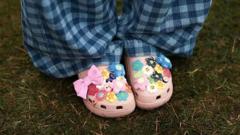The Rise of Trainers: A New Era for Footwear?
3 min read

In a surprising turn of events, Crocs, the iconic rubber clog maker, has reported a significant decline in sales within the United States. This downturn is attributed to a growing consumer preference for trainers, especially with the anticipated excitement surrounding the upcoming World Cup. This trend marks a shift in the footwear landscape that could redefine the industry’s dynamics.
Crocs: A Brief Legacy
Crocs have long been celebrated for their practicality, comfort, and unmistakable design. Launched in 2002, the brand quickly gained popularity for its unique aesthetic and functionality, becoming a staple for both casual wear and specific professional settings, like healthcare and culinary industries. Crocs’ ability to capture the zeitgeist with collaborations and limited-edition drops further cemented its place in pop culture.
However, the recent decline in Crocs’ U.S. sales underscores a significant change in consumer preferences. The rise of trainers is not just a fleeting trend but a reflection of shifting lifestyle choices and broader cultural movements.
The Athletic Trend: More Than Just Fashion
The increasing popularity of trainers is part of a larger "athleisure" movement that has been gaining momentum over the past decade. The term "athleisure" refers to casual, comfortable clothing designed to be suitable both for exercise and everyday wear. It represents a blurring of lines between traditional athletic wear and street fashion.
As the World Cup approaches, the global focus on athletic events further fuels this trend. Major sports tournaments often inspire a spike in sports-related merchandise sales, and trainers are no exception. Consumers are not only looking for functionality but also for products that align with a more active, health-conscious lifestyle that athletic events often promote.
The Evolution of Trainer Culture
Trainers have evolved from their humble beginnings as purely functional athletic footwear to a symbol of lifestyle and identity. The sneaker culture, which began in the late 20th century, has transformed how consumers perceive and purchase footwear. Once a niche market dominated by sports enthusiasts, trainers are now at the forefront of fashion, with high-end brands and designers collaborating to produce limited-edition pieces that fetch high prices.
This cultural shift is driven largely by millennials and Generation Z, who value comfort, versatility, and sustainability. These generations are more likely to invest in a pair of trainers that can transition from a gym session to a casual outing, reflecting their dynamic and multifaceted lives.
The Road Ahead for Crocs
For Crocs, the challenge lies in adapting to this evolving landscape. While the company has successfully revitalized its brand through strategic partnerships and innovative designs, it must now navigate the complexities of a market increasingly dominated by trainers.
Innovation and diversification could be key to Crocs’ strategy moving forward. By exploring new materials, design collaborations, and eco-friendly production methods, Crocs can appeal to a broader audience and align with contemporary consumer values.
Conclusion: Embracing Change
The decline in Crocs' U.S. sales serves as a reminder of the ever-evolving nature of consumer preferences and industry trends. As trainers continue to gain traction, it is clear that the footwear industry is in the midst of a significant transformation. Brands must remain agile, embracing change and innovation to meet the demands of a new generation of consumers.
In the dynamic world of fashion, adaptability is paramount. Whether Crocs can pivot successfully remains to be seen, but the rise of trainers presents both a challenge and an opportunity for the footwear industry as a whole.
